 |
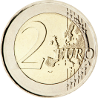 |
C o m m e m o r a t i v e
C o i n s |
||
| Ireland | |||||||
The edge embossing on the Irish 2‐Euro‐commemorative coins is : |
|||||||
| Image | Country | Date | Feature | Ref. | Volume | ||
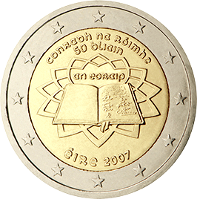 🔎
🔎 |
 |
Ireland | 26 Mar. 2007 | 50th anniversary of the Signature of the Treaty of Rome |
20001 20002 20005 |
4,651,112 |  |
National characteristics : At the top are the words "conradh na Róimhe" (Treaty of Rome) and "50 bliain" (50 years), below it is an illustration of the treaty with the words "an eoraip" (Europe), below that is the year "2007" and the country name "ÉIRE" (Ireland). The coin was minted without mint marks by the Irish mint Lárionad Airgeadra an Bhainc Ceannais / Central Bank Currency Centre in Áth an Ghainimh / Sandyford. Coins in the proof production process version were made by the Finnish mint Suomen Rahapaja OY in Vantaa. |
|||||||
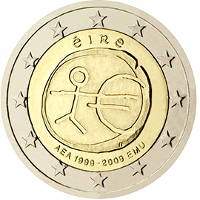 🔎
🔎 |
 |
Ireland | 01 Jan. 2009 | 10th anniversary of the Economic and Monetary Union (EMU) |
20001 20002 20005 |
3,812,908 |  |
National characteristics : Above is the name of the issuing country "ÉIRE" (Ireland), the acronym of the occasion of issue below is shown on the left with "AEA" (in Irish) and on the right of the years with "EMU" (in English). The coin was minted without mint marks by the Irish mint Lárionad Airgeadra an Bhainc Ceannais / Central Bank Currency Centre in Áth an Ghainimh / Sandyford, coins minted in the proof production process were made by the Royal Dutch mint Koninklijke Nederlandse Munt in Utrecht. |
|||||||
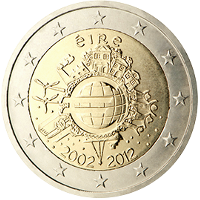 🔎
🔎 |
 |
Ireland | 03 Jan. 2012 | 10th anniversary of the Euro‐Currency |
20001 20002 20005 |
1,354,867 |  |
National characteristics : At the top of the coin is the name of the issuing country "ÉIRE" (Ireland). The coin was minted without mint marks by the Irish mint Lárionad Airgeadra an Bhainc Ceannais / Central Bank Currency Centre in Áth an Ghainimh / Sandyford. Coins minted in the proof production process were made by the Royal Dutch mint Koninklijke Nederlandse Munt in Utrecht. |
|||||||
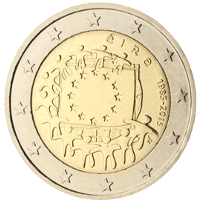 🔎
🔎 |
 |
Ireland | 16 Oct. 2015 | 30th anniversary of the EU‐Flag |
20001 20002 20005 |
1,000,000 |  |
National characteristics : Above is the name of the issuing country "ÉIRE" (Ireland), followed by the dates "1985‐2015". The coin was minted without mint marks by the Irish mint Lárionad Airgeadra an Bhainc Ceannais / Central Bank Currency Centre in Áth an Ghainimh / Sandyford. Coins minted in the proof manufacturing process were made by the Austrian mint Münze Österreich AG in Vienna. |
|||||||
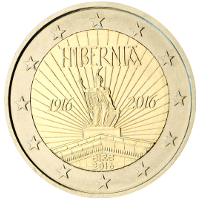 🔎
🔎 |
 |
Ireland | 20 Jan. 2016 | 100th anniversary of the 1916 Easter Rising in Ireland |
20001 20002 20005 |
4,500,000 |  |
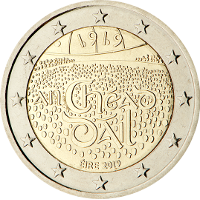 🔎
🔎 |
 |
Ireland | 21 Jan. 2019 | Centenary of the first sitting of Dáil Éireann (House of Assembly) |
20001 20002 20005 |
1,000,000 |  |
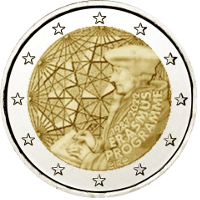 🔎
🔎 |
 |
Ireland | 01 Jul. 2022 | 35th anniversary of the Erasmus Program |
20003 20005 20009 |
500,000 |  |
National characteristics : The quarter circle at the bottom right has four lines; below the commemorative period, the issue occasion "ERASMUS PROGRAMME" (in English) is written in two lines, below which is the issuing country "ÉIRE" (Ireland). The coin was minted by the Irish Mint Lárionad Airgeadra an Bhainc Ceannais / Central Bank Currency Centre in Áth an Ghainimh / Sandyford without mintmarks. |
|||||||
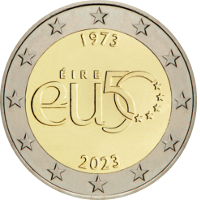 🔎
🔎 |
 |
Ireland | 22 Jun. 2023 | 50th anniversary of accession to the EU |
20003 20008 20009 |
501,000 |  |
| References : | |||
| 20001 | Images taken with authorisation by the ECB ‐ Mail dated 20.Feb.2020 © "European Central Bank" |
20002 | Data mirrored from Wikipedia Page "2_euro_commemorative_coins" with friendly support of the guardians of that page. |
| 20003 | Not Applicable | 20004 | Coloured version of this Commemorative Coin in circulation EU‐legal‐technical specifications do not recongnise colour prints. The EU nevertheless tolerates them, as their numbers are very small and they are sold in special packs and therefor are very unlikely to be used as currency. |
| 20005 |
enlarged Images taken with authorisation by Gerd Seyffert © "Gerd Seyffert 2021" |
20006 | Not Applicable |
| 20007 | Images taken by Münzen Kreuzberg © "Münzen Kreuzberg 2021" |
20008 | enlarged Images taken by Münzen Kreuzberg © "Münzen Kreuzberg 2021" |
| 20009 | Text with kind permission by Gerd Seyffert © "Gerd Seyffert 2023" |
20010 | Not Applicable |
 |


